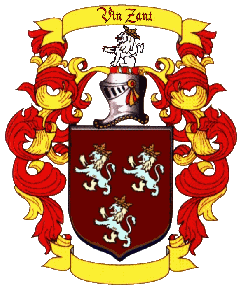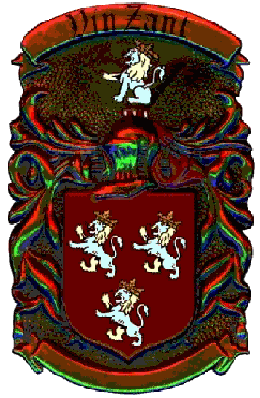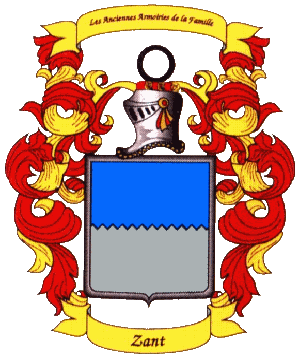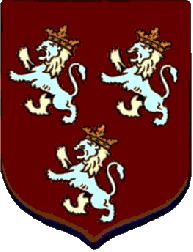What is a Crest?
Much like the crest of a bird from which the name is derived early crests consisted of the placement of feathers or hair on the top of a soldier’s helmet. Some a fan of plumes in alternating colors, or a pair of curving horns. Later crests took the form of animals, especially lions or bird's wings. Some showed only the fore half of human figures from the waist up or just hands or arms holding weapons.. These three-dimensional figures where placed on the top of the mounted knights' helms and was a further means of identification. A kind of calling card as you will.
Modern crest evolved from these three-dimensional figures.
As it pertains to the coat-of-arms, the crest rests on top of a helmet which itself rests on the most important part of the achievement—the shield. The crest is usually found on a wreath of twisted cloth and sometimes within a coronet.
Today one may find a crest worn on peaces of clothing or belt buckles. Though truly, the crest may only be worn by the actual owner of the crest or his direct descendents.
The Motto.
Another key element to a coat-of-arms is the addition of a motto. A motto is a phrase or collection of words intended to describe the motivation or intention of the armigerous person or corporation. Generally the motto is placed on a banner just below the Blazon.
Not all coat-of-arms have mottoes, ours does not, though on the Origin of Names coat-of-arms top banner it does appear to have a motto. The words are in French (Les Anciennes Armoiries de la Famille). So I looked the phrase up in a- French to English dictionary. Roughly translated it simpily says, “The Ancestral Coat-of-Arms of the Family ”. Not a motto after all.

Many families in Europe were awarded coats-of-arms during the medieval period of history. They were awarded by the governments or monarchies and were often recorded in what was called a “ College of Heraldry”.
Coat-of-arms are still being recorded today, mostly in countries who still maintain monarchies like England and her colonies. There are many commercial venders that will design a coat-of-arms for you, though you may not be able to get it registered.
This coat-of-arms is one I made by combining the Mantling from the Origin of Names coat-of-arms with the Blazon from the House of Heraldry’s coat-of-arms. All of the important elements are still there.


My Family
Crest
The Coat-of-Arms
Do the Vin Zant’s have a Crest or a Coat-of-Arms?
Among the first questions people ask me when they become interested in family history is do the Vin Zant’s have a family crest or coat-of-arms. After all there are thousands of names in these big thick books at fairs and in the mega-malls during the holiday seasons. At these places there is always some amateur heraldic expert who is most eager to print out you a family coat-of-arms complete with a history of the origin of your name. But are they accurate? Most likely not, at best they are a general description of the origin of your name and the coat-of-arms is one of many that may be associated with your name. So how do you find your coat-of-arms? With a lot of research. The first thing you will need is the true origin of your family.
Sill I digress to answer the first question, honestly to the best of my knowledge there is no authentic registered coat-of-arms for the name Vin Zant. But let me continue, please read on.
This coat-of-arms is from a mall booths I went too, back in 1979. It was run by a company called The House of Heraldry. This company was much different then the ones you see today they had no fancy computers ready to crank you out a coat-of-arms and family history. They just had a lot of old dusty books.
{Note: Books are those funny looking things with the hard covers and lots of paper pages inside with writing on them. You know the thing people put on chairs in order to reach high places or to prop up a small child so they can reach the table. Those are books.} :-)
Oh sorry, where was I? Oh yah! Well I sat down with the gentleman who ran the store and he asked me what I knew about my name and about where my family heralded from. I proceeded to tell him the story often told to be by my grandmother that we came from Alsace Larraine France.
Well he looked through a number of books and did not find a listing for the name Vinzant.
I told him that we spelled the name with a space and a capital Z. Though, he was already way ahead of me and was quickly looking up the name Zant. He discovered that Zant is from the German spelling Zandt. The first requester for the name Zandt was in BADEN-BADEN. This official register was for “Zandt, van, der.” There were other listings for Zandt even some for Zand another spelling variation. But Zandt-van-der was registered at the nearest city of register to legendary origin of our family, Alsace Larraine France.
So I chose this coat-of-arms and crest as my family coat-of arms and crest.
On a visit to one of our summer festivals back in 1997. I stopped by a booth called the Origin of Names. They were selling a document form a company called The Hall of Names. They advertised a coat-of-arms for your family name and included a history of the name. Again I was not able to find Vin Zant in their list nor did I expect to. I did come upon the name "Zant," which did have a coat-of- arms.
I know what you are thinking why would I trust this high tech mass-produced computer generated heraldry and history. To start I wasn't really interested in there version of the coat-of-arms but I did want to see the back story they had on the origin of the name Zant. Yet the only way to read the story was to purchase a copy. So I purchased the computer write-up about the history of the name Zant that accompanied the coat-of- arms and was not surprised to read that they gave the origin of the family as coming from Germany near France.
Later after returning home I looked at a paper I got with the first coat of arms back in 79 from The House of Heraldry. It was a photocopy from the book that they used to find my first coat-of-arms. I discovered that the Hall of Names coat-of-arms is actually for the surname Zand. The fact is there's a coat-of-arms for most every version of the surname Zant.
The Zand coat-of-arms
{Note: It is marked Zant on the lower banner this is an exact copy of the printed coat-of-arms from the Hall of Names.}


What is a Coat-of-Arms?
The coat-of-arms or “Blazon” is composed of a Field (background) with the various Charges (markings) that represent your family. It is most often shaped like a shield. Everything else around the field the Mantling are mostly just garland used to dress-up the coat-of-arms. Supporters figures usually placed on either side of the shield may have local significance, such as the fisherman and the tin miner granted to Cornwall County Council, or an historical link, such as the lion of England and unicorn of Scotland.
A blazon follows a rather rigid formula.
- Every blazon begins by describing the field . In a majority of cases this is a single tincture, e.g. Gules (red).
- Next the principal charges are named, with their tinctures; three Lions - Rampant - Argent (white).
- The principal charge is followed by any charges placed around or on it.in this case Crown - Or (gold)



